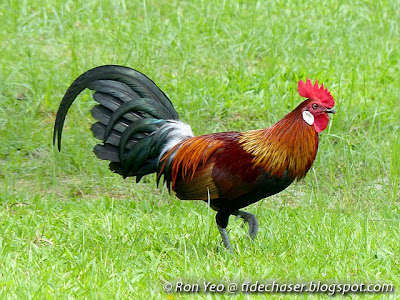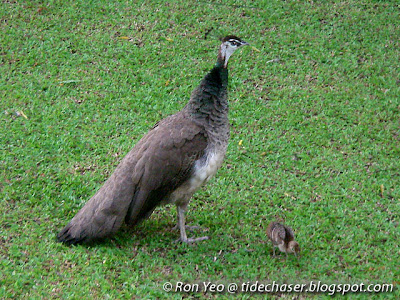Fowls (phylum Chordata, subphylum Vertebrata, superclass Tetrapoda, class Aves, order Galliformes) refer to chicken or chicken-like birds which usually have colourful feathers, elaborated head skins, feathers and/or other ornaments, and a relatively small head compared to the body. They usually exhibit sexual dimorphism, with the males more brilliantly coloured, or equipped with special feathers and/or other ornaments for courtship display. Some species, such as the chicken, quails, turkeys, pheasants and peacocks, are domesticated either for consumption or as pets.
Singapore has two native fowls - the Blue-breasted Quail and the Red Junglefowl, though a few exotic species have also established their presence in some areas.
Here are the fowls that I managed to photograph in Singapore:

The Red Junglefowl (Gallus gallus) is the wild relative of the domestic chicken, and both are of the same species. The former, however, can be differentiated from the latter by the white cheek, white rump, grey legs, and the calls of the male which have an abrupt ending. They are usually found in wooded areas, forest edges and open areas near forests. The above photo features a rooster, also called a cockerel or cock, which is the male.

The female, also called a hen, is usually brown and black. The chicks are brownish. Red Jungelfowls grow to about 70cm long, and fees on seeds and insects.

Many of the Red Junglefowls on mainland Singapore are breeding with feral chicken, and possibly as a result of the lack of gene diversity, white fowls have been seen in recent years. It is not known whether this is a result of albinism or leucism.

The Blue Peafowl (Pavo cristatus) has been introduced to a few parts of Singapore, and is breeding well especially on Sentosa and St John's Island. The above photo features a peacock (i.e. the male), which has a deep blue head and neck, and iridescent greenish-blue display feathers which it opens up like a fan during courtship. From the head to the end of the display feathers growing on its back, it can reach lengths of more than 2m.

Both males and females have a fan-shaped crest on their heads. The above photo features a peahen with a chick. The female has a greyish-brown plumage. Peafowls feed on seeds, insects and other small animals.

Several leucistic white peafowls, which appear white due to reduced pigmentation as a result of recessive genes, can be seen on Sentosa and St John's Island.
References
Singapore has two native fowls - the Blue-breasted Quail and the Red Junglefowl, though a few exotic species have also established their presence in some areas.
Here are the fowls that I managed to photograph in Singapore:

The Red Junglefowl (Gallus gallus) is the wild relative of the domestic chicken, and both are of the same species. The former, however, can be differentiated from the latter by the white cheek, white rump, grey legs, and the calls of the male which have an abrupt ending. They are usually found in wooded areas, forest edges and open areas near forests. The above photo features a rooster, also called a cockerel or cock, which is the male.

The female, also called a hen, is usually brown and black. The chicks are brownish. Red Jungelfowls grow to about 70cm long, and fees on seeds and insects.

Many of the Red Junglefowls on mainland Singapore are breeding with feral chicken, and possibly as a result of the lack of gene diversity, white fowls have been seen in recent years. It is not known whether this is a result of albinism or leucism.

The Blue Peafowl (Pavo cristatus) has been introduced to a few parts of Singapore, and is breeding well especially on Sentosa and St John's Island. The above photo features a peacock (i.e. the male), which has a deep blue head and neck, and iridescent greenish-blue display feathers which it opens up like a fan during courtship. From the head to the end of the display feathers growing on its back, it can reach lengths of more than 2m.

Both males and females have a fan-shaped crest on their heads. The above photo features a peahen with a chick. The female has a greyish-brown plumage. Peafowls feed on seeds, insects and other small animals.

Several leucistic white peafowls, which appear white due to reduced pigmentation as a result of recessive genes, can be seen on Sentosa and St John's Island.
References
- Briffett, C. 1986. A guide to the common birds of Singapore. Singapore Science Centre. 160 pp.
- Ramesh, K. & P. McGowan. 2009. On the current status of Indian Peafowl Pavo cristatus (Aves: Galliformes: Phasianidae): keeping the common species common. Journal of Threatened Taxa 1 (2): 106–108.
- Robson, C. 2010. New Holland field guide to the birds of South-East Asia. London: New Holland Publishers. 304 pp.
- Singapore Birds. Retrieved Mar 25, 2013, http://singaporebirds.blogspot.sg
- Strange, M. 2000. Photographic guide to the birds of Southeast Asia. Singapore: Periplus. 398 pp.

2 comments:
Love your blog. Keep up the good work! All the information helped a lot :) It is definitely heartwarming to see someone so dedicated to nature!
Thanks!
Post a Comment